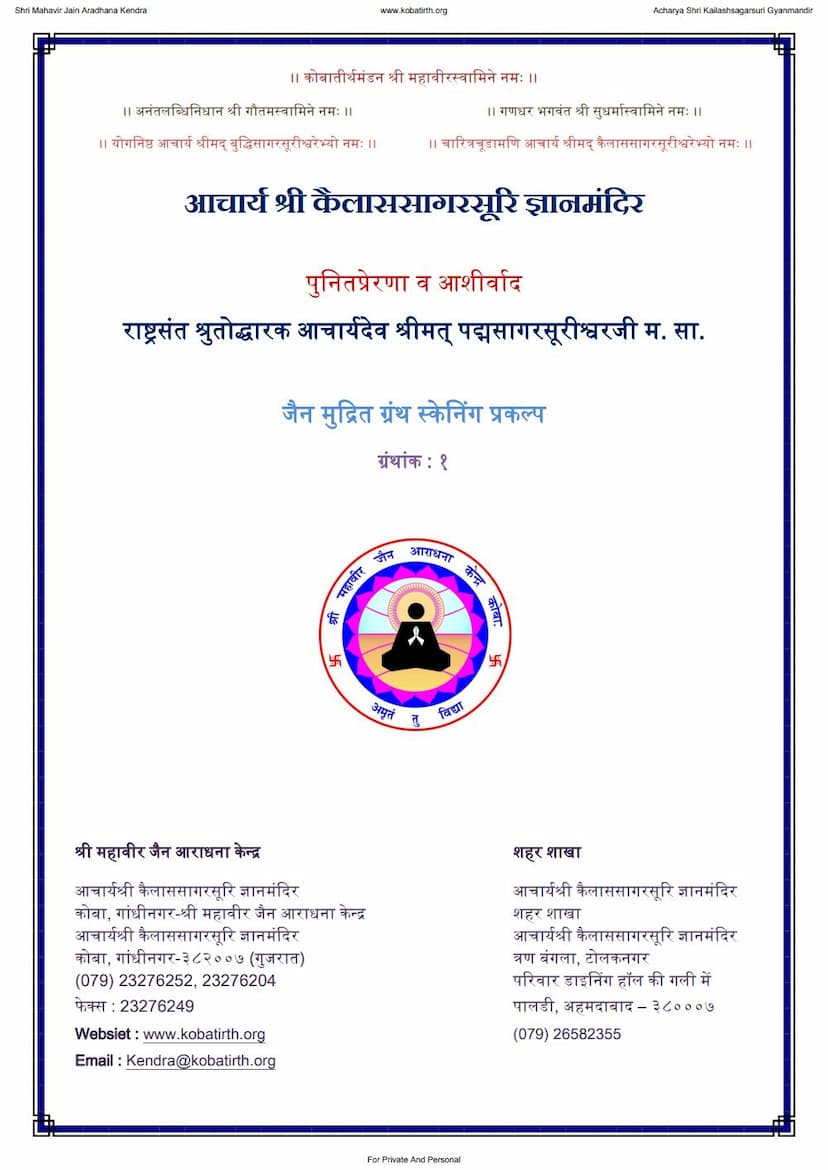Updeshmala ऊIka
Added to library: September 2, 2025

Summary
This document is a detailed commentary (टीका - Tika) on the Jain text "Updeshmala" (उपदेशमाला), authored by Dharmdas Gani and commented upon by Ramvijay Gani. The publication is attributed to Shravak Hiralal Hansraj. The catalog link provided (jainqq.org) suggests it's part of a larger collection of Jain scriptures, likely digitized for preservation and accessibility.
The text is presented as part of a project by the Shri Mahavir Jain Aradhana Kendra and Acharya Shri Kailashsagarsuri Gyanmandir, indicating a focus on preserving and disseminating Jain knowledge.
Summary of the Content:
The provided text consists of the initial pages of the commentary, which lay the groundwork for the discourse by:
-
Invocation: The text begins with traditional Jain invocations (namaḥ) to Shri Mahavir, Shri Gautam Swami, Acharya Buddhisagar Suri, Shri Sudharma Swami, and Acharya Kailashsagarsuri. It also acknowledges the inspiration and blessings of Rashtrasant Shrutoddharak Acharya Dev Shrimat Padmasagarsurishwarji. The project is identified as part of the "Jain Mudrit Granth Scanning Project."
-
Title and Authorship: The title page clearly states "Shri Jinay Namah || Shri Updeshmala Tika || Moolkar - Shri Dharmdas Gani - Tika Kar - Shri Ramvijay Gani." It also mentions the publisher, Pandit Shravak Hiralal Hansraj of Jamnagar, and the publication year (Samvat 1966).
-
Purpose of the Commentary: The Tika begins with an invocation and a statement of purpose by the commentator (Ramvijay Gani). He aims to elucidate the "Updeshmala," a text composed by Dharmdas Gani for the instruction of his son. The commentator acknowledges the existence of other commentaries but deems his own effort to be beneficial, comparing it to lighting a lamp even when the moon is present.
-
Introduction to the Narrative: The commentary immediately dives into the narrative by introducing the first example or story that illustrates the teachings of the Updeshmala. This story begins with the character of Ranasingh.
- The setting is Vijaypur, ruled by King Vijaysen.
- King Vijaysen has two sons, Ajay and Vijaya.
- The queen, Vijaya, becomes pregnant.
- The king's other wife, Ajaya, conspires with a midwife to substitute a stillborn child for Vijaya's newborn son. Ajaya receives the stillborn child, and her own son's placenta (गज - gaj) is given to Ajaya.
- The manipulative midwife is instructed to dispose of the stillborn child, but she feels remorse and leaves the infant in a pile of grass near a well instead of killing it.
- A kind householder named Sundar finds the abandoned infant, names him Ranasingh, and raises him as his own son.
- King Vijaysen is informed that his son is dead, which causes him great sorrow and detachment from worldly affairs. He renounces the kingdom and takes diksha (monkhood) under Lord Mahavir.
- Ranasingh grows up, performs his duties, and is eventually guided by a Charana Muni (a type of enlightened monk) to understand the transient nature of life and the importance of devotion to the Jinas. He is advised to visit the temple daily.
-
Key Themes Introduced: Even in these initial pages, several key Jain themes are evident:
- Karma: The narrative highlights the consequences of actions, both good (finding Ranasingh) and bad (Ajaya's conspiracy).
- Detachment and Renunciation: King Vijaysen's renunciation upon learning of his son's supposed death exemplifies detachment from worldly possessions and pleasures.
- Right Faith and Conduct: The influence of monks and their teachings (dharma upadesh) in guiding individuals towards spiritual understanding and practice is emphasized.
- Importance of Jina Devotion: The story points towards the significance of worshipping the Jinas.
- The Value of Virtue: The kindness of Sundar and the spiritual guidance offered by the monk underscore the importance of virtuous actions.
Overall Purpose of the Text:
"Updeshmala Tika" aims to explain the profound spiritual teachings embedded within "Updeshmala" through illustrative stories and examples. The commentary focuses on imparting moral and spiritual lessons to the readers, guiding them towards righteous living, detachment from worldly affairs, and ultimately, the path to liberation as taught in Jainism. The story of Ranasingh serves as an early illustration of destiny, divine intervention, and the power of spiritual guidance.